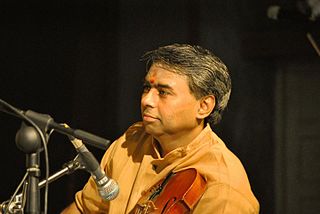
Kattassery Joseph Yesudas is an Indian musician and playback singer. Yesudas sings Indian classical, devotional and cinematic songs. He has recorded more than 80,000 songs in a number of Indian languages, including Malayalam, Tamil, Hindi, Kannada, Bengali, and Telugu as well as Arabic, English, Latin, and Russian, during a career spanning more than five decades.

T. V. Sankaranarayanan is a Carnatic vocalist, known for his music that stems from the style of his late uncle-guru, Madurai Mani Iyer. He was awarded the Madras Music Academy's Sangeetha Kalanidhi in 2003.

Semmangudi Radhakrishna Srinivasa Iyer was a Carnatic vocalist. He was the youngest recipient of the Sangeetha Kalanidhi awarded by the Music Academy in 1947 and has received many awards including Padma Bhushan and Padma Vibhushan from the Government of India, Sangeet Natak Academy award (1953), Isai Perarignar from Government of Tamil Nadu and Kalidas Samman from Government of Madhya Pradesh. He was affectionately addressed as "Semmangudi Maama" by his disciples. He, along with his contemporaries G.N. Balasubramaniam and Madurai Mani Iyer, are referred to as the 20th century male trinity of Carnatic music. He was also considered the "Pitamaha" or the grand sire of modern Carnatic Music. He was conferred with an honorary doctorate by University of Kerala in 1979.
Gudalur Narayanaswamy Balasubramaniam, popularly known as GNB, was an Indian Carnatic singer. He innovated the art through emphasis on laya control and reducing the gamakas which eventually made Carnatic music appeal to the lay and the learned alike. He, along with his contemporaries Semmangudi Srinivasa Iyer and Madurai Mani Iyer, are referred to as the 20th century male trinity of Carnatic music. He was also a Tamil film actor.

Music of Tamil Nadu has a long tradition and history going back thousands of years. Music is a very important aspect of the culture of the Tamil people.

Ariyakudi Ramanuja Iyengar, popularly known as Ariyakudi, was a Carnatic music vocalist, born in Ariyakudi, a town in Ramanathapuram district]] of Tamil Nadu. Ariyakudi developed a unique style of singing which came to be known as The Ariyakudi Tradition and is followed by his students. He established the modern katcheri (concert) traditions in Carnatic music.
Thanjavur Brinda (1912-1996) was one of the representatives of the Veenai Dhanammal school of Carnatic Music. She was primarily a vocalist, although she also played the Veena. She is affectionately referred to as 'Brindamma', by her fans.

Harikesanallur Muthiah Bhagavatar, commonly known as Muthiah Bhagavatar, is one of Carnatic classical music's famous twentieth-century composers. He also created about 20 ragas.
Maharajapuram Viswanatha Iyer (1896–1970) was one of the great Indian Carnatic vocalists. He won several awards including Sangeetha Kalanidhi and Sangeetha Bhupathy.

Musiri Subramania Iyer was a Carnatic vocalist whose stage performing career spanned the 1920s to the 1940s. After retirement from the stage, he remained an iconic figure in Carnatic music as a dedicated teacher and leader in the Carnatic community. His bhava-laden renditions of Carnatic songs have become the measuring stick for generations of Carnatic vocalists. Musiri Subramania Iyer is one of the giants of Carnatic music in this century.

Umayalpuram Kasiviswanatha Sivaraman is a Carnatic mridanga vidwan. He was awarded the Madras Music Academy's Sangeetha Kalanidhi in 2001. He is the son of Sri P. Kasiviswanatha Iyer and Srimati Kamalambal. His father was a medical doctor by profession but encouraged his musical pursuits.

Anuradha Sriram is an Indian carnatic and playback singer who hails from the Indian state of Tamil Nadu. She has sung more than 3,000 songs in Tamil, Telugu, Malayalam, Kannada and Hindi films.

Sirkazhi Govindarajan was a leading vocalist in Carnatic Music.

Anandathandavapuram is a village in Mayiladuthurai taluk, Nagapattinam district, Tamil Nadu. The nearest town, Mayiladuthurai is located five kilometers, southerly. Anandathandavapuram has a small railway station which is located within the limits of the village. From this village there are direct trains to Chennai, Tiruchirapalli, Thanjavur, Chidambaram, Vaitheeswaran Temple etc.

R. K. Shriramkumar is a virtuoso violinist and accompanist of the Carnatic Music. He hails from the Rudrapatna family of musicians from Karnataka. He is the grandson of the violinist R. K. Venkatarama Shastri and grand-nephew of R. K. Srikanthan.

Mahathi is a Carnatic musician and playback singer for film songs in several Indian languages.
K. S. Narayanaswamy, was a Carnatic veena exponent of the Thanjavur style, in which nuances and subtleties are given more importance over rhythm based acrobatics. He was awarded the Madras Music Academy's Sangeetha Kalanidhi in 1979.
Mayavaram V. R. Govindaraja Pillai was a Carnatic violinist from Tamil Nadu, Southern India.
The Pathans of Tamil Nadu are Urdu-speaking Muslims of Pashtun ancestry who have migrated to and settled in the South Indian state of Tamil Nadu. Their migration to the Tamil country had occurred in three main waves - first during the Madurai Sultanate between 1335 and 1378, second during the Mughal incusrions into the Tamil country of the reign of Aurangazeb and the subsequent establishment of the Carnatic state and lastly, during British rule when both the Tamil country as part of the Madras Presidency and the North West Frontier Province which formed part of the Pashtun homeland, were both components of the British Empire. Pathans in Tamil Nadu are generally called Pattan or Pattani and form a part of the larger Urdu-speaking community of Tamil Muslims. The hereditary chief of the Pathans of Tamil Nadu is the Nawab of Arcot.
Zee Tamil's Sa Re Ga Ma Pa 2009 Challenge was a reality-based Indian singing competition that aired on Tamil language TV channel Zee Tamil. It was designed to be a talent hunt in Tamil Nadu. The top 15 contestants would have an opportunity to perform with celebrity singers during the main stage of the competition. The show was sponsored by Clinic Plus.
















